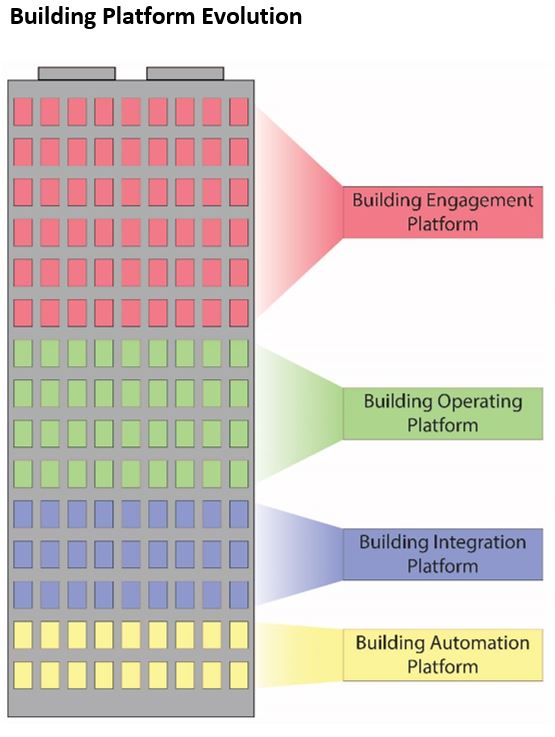|
December 2019
AutomatedBuildings.com
|
[an error occurred while processing this directive]
(Click
Message to Learn More)
|
The Evolution of the Building Platform
The age of IoT, IP and digital transformation are increasingly common
across a range of industries and are revolutionizing them. No
industry is immune, and most certainly, not ours.
|

Marc Petock
Chief Marketing & Communications Officer
Lynxspring, Inc.
Contributing Editor
|
The
age of IoT, IP and digital transformation are increasingly common
across a range of industries and are revolutionizing them. No
industry is immune, and most certainly, not ours.
 The
past several years have demonstrated that digital transformation and
the evolving of IoT and IP within the built environment continues on an
upward climb, delivering undeniable value to owners, operators and
occupants alike. The rate of change can be attributed not only to
diverse technologies and innovation, but also changes driven by
connectivity, the Edge, the value of data, the Cloud, cyber and new
business outcomes.
The
past several years have demonstrated that digital transformation and
the evolving of IoT and IP within the built environment continues on an
upward climb, delivering undeniable value to owners, operators and
occupants alike. The rate of change can be attributed not only to
diverse technologies and innovation, but also changes driven by
connectivity, the Edge, the value of data, the Cloud, cyber and new
business outcomes.
With
this evolution, we’ve seen the emergence of more advanced buildings and
what they are capable of delivering and what we are asking them to
deliver. Instead of being static structures, digital transformation and
IoT have turned facilities into dynamic environments fostering
innovation, producing improved operational performance and creating
meaningful, occupant experiences.
Alongside
this transformation has been the accelerated evolution of how we
identify the “building platform.” We first began this journey with the Building Automation Platform.
Simply put, Building Automation Platforms controlled and monitored the
building's mechanical and electrical equipment such as HVAC, lighting,
power and security systems.
Next, as buildings became more technology-enabled, we moved to the Building Integration Platform. The Building Integration Platform
acted as a front-end and protocol translator and coordinated the
operation of various systems, equipment, applications and services. It
formed a middleware framework that enabled the integration and
interoperability of multiple systems and equipment functions across the
building and an enterprise.
Then, as we added “smart” and “intelligent” to the equation, we moved to the Building Operating Platform.
The Building Operating Platform, connected, integrated and correlated
data from facility equipment, systems and devices, and enabled facility
personnel and operators to adopt a converged and common network to
achieve automation, integration, energy and operational efficiencies.
It provided operators with a system from which to manage and understand
how their buildings were performing, managed energy and made use of a
common user interface to all systems, equipment and devices.
Let’s turn to today. Leveraging digital technology is not new. What is different is what I call the Building Engagement Platform.
Our buildings are no longer passive places where we just work. They are
digitally enabled, and they are social. They have become ecosystems and
places of engagement in which there are interactions between occupants
and their surrounding environments, communications between IT and OT,
exchanges between HR and facility management---all to create engaging
experiences to make the workplace smart, comfortable, safe, productive,
healthy, secure, achieve higher levels of performance and become
adaptive, meaningful environments.
The Building Engagement Platform combines previous platform generations
on a flatten, secured IP horizontal architecture with the touchpoints,
tools, ingestion of real-time data streams and workplace applications.
It streamlines efficiencies, manages workflows and allows for
collaboration and information sharing in order to meet occupant
experience expectations, drive new service delivery and produce new
outcomes. The most important perspective resulting from the building
engagement platform is the relationship between technology and outcomes
and the roles each play in driving value.
Our
engagement with buildings and facilities is constant and far from
finished. The building platform journey is continuous. Whether you are
an owner, operator, service provider or occupant, you have expectations
when it comes to an engaging experience. The role of IP and IoT, as
well as transformation, is essential in this evolution and continues to
change the market. Buildings that don’t follow this evolution will have
decreased value.
footer
[an error occurred while processing this directive]
[Click Banner To Learn More]
[Home Page] [The
Automator] [About] [Subscribe
] [Contact
Us]